Ukkusiksalik National Park management plan 2018
Ukkusiksalik National Park
- Ukkusiksalik National Park of Canada Management Plan 2018 (PDF, 2.70 Mb)
Table of contents
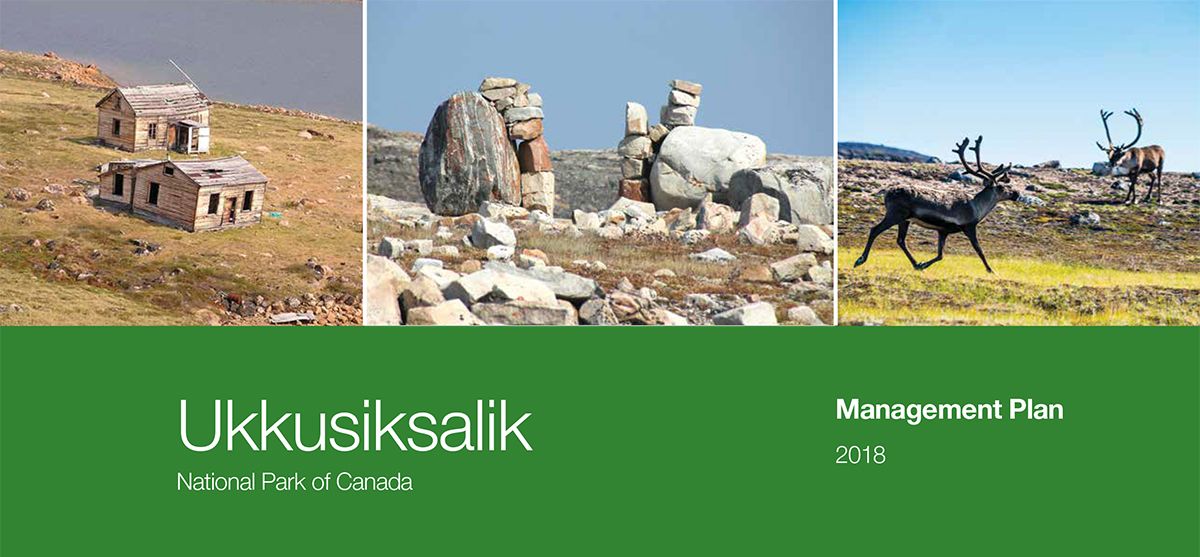
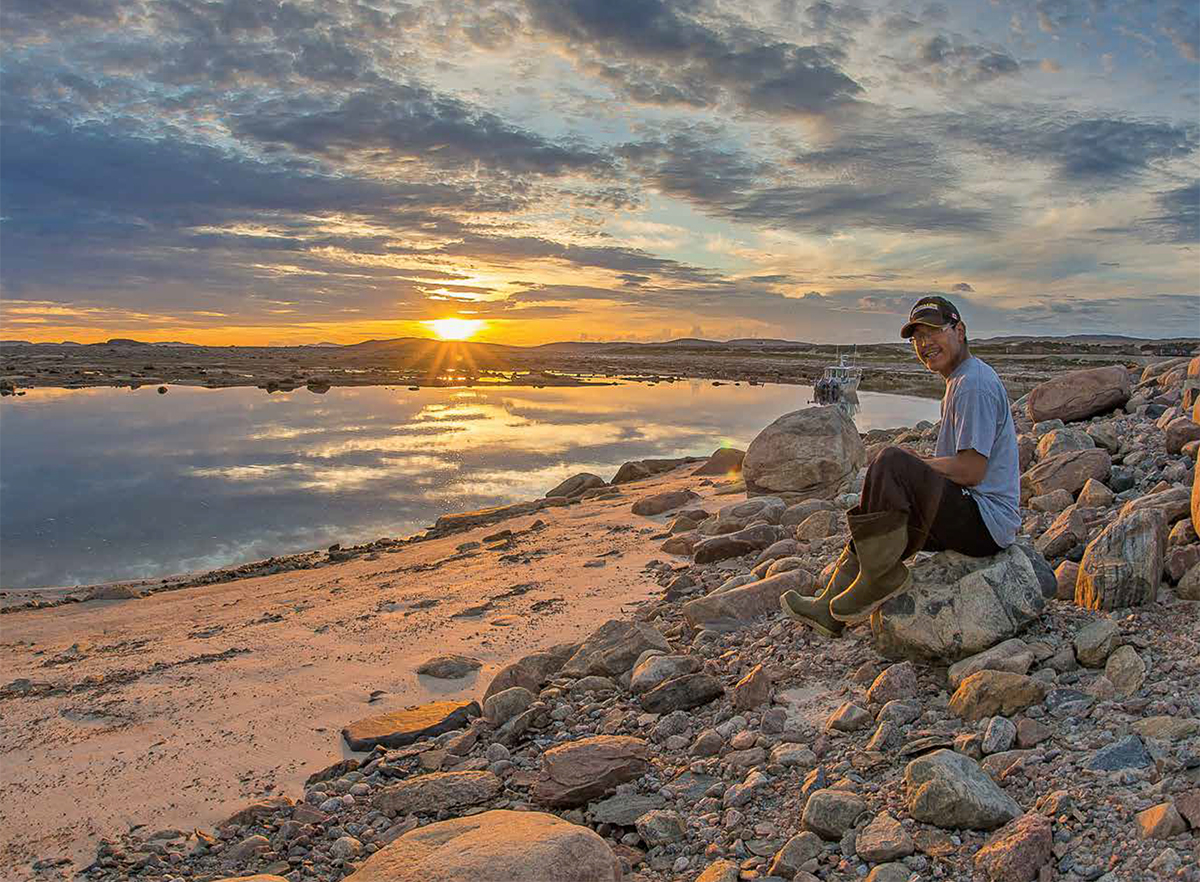
© Her Majesty the Queen in Right of Canada, represented by the Chief Executive Officer of Parks Canada, 2018.
Cette publication est aussi disponible en français.
Library and Archives Canada Cataloguing in Publication
- Parks Canada
- Ukkusiksalik National Park of Canada management plan, 2018.
Issued also in French under the title:
Parc national du Canada Ukkusiksalik, plan directeur
Issued also in Inuktitut under the title:
ᐅᒃᑯᓯᒃᓴᓕᒃ ᒥᕐᖑᐃᕐᓯᕕᒃ ᑲᓇᑕᒥ ᐊᐅᓚᑦᑎᓂᕐᒧᑦ ᐸᕐᓇᐅᑏ 2018ᒥ
Available also on the Internet
- Catalogue No.: R64-496/2018 PDF: R64-496/2018E-PDF
- ISBN 978-0-660-08914-9 PDF: 978-0-660-08911-9
- Ukkusiksalik National Park -- Management.
- National parks and reserves -- Nunavut --Management.
- National parks and reserves – Canada -- Management. I. Title.
For more information about the management plan or about Ukkusiksalik National Park:
P.O. Box 220
Naujaat (Repulse Bay), Nunavut
Canada
X0C 0H0
Front Cover Image Credits
top from left to right: Parks Canada Agency
bottom: Parks Canada Agency
Foreword

Canada’s national parks, national historic sites and national marine conservation areas belong to all Canadians and offer truly Canadian experiences.
These special places make up one of the finest and most extensive systems of protected natural and cultural heritage areas in the world.
The Government is committed to preserving our natural and cultural heritage, expanding the system of protected places and contributing to the recovery of species-at-risk. At the same time, we must continue to offer new and innovative visitor and outreach programs and activities so that more Canadians can experience Parks Canada places and learn about our environment, history and culture.
This new management plan for Ukkusiksalik National Park of Canada supports this vision.
Management plans are developed through extensive consultation and input from various people and organizations, including Indigenous peoples, local and regional residents, visitors and the dedicated team at Parks Canada.
National parks, national historic sites and national marine conservation areas are a priority for the Government of Canada.
I would like to thank everyone who contributed to this plan for their commitment and spirit of co-operation.
As the Minister responsible for Parks Canada, I applaud this collaborative effort and I am pleased to approve the Ukkusiksalik National Park of Canada Management Plan.
Original signed by:
Recommendations
Recommended and original signed by:
Michael Nadler
Acting Chief Executive Officer
Parks Canada
Trevor Swerdfager
Senior Vice-President, Operations
Parks Canada
Jenna Boon
Field Unit Superintendent - Nunavut Field Unit
Parks Canada
Jackie Nakoolak
Chair
Ukkusiksalik Park Management Committee
Nunavut Wildlife Management Board
May 31, 2018
Dear Minister,
The Nunavut Wildlife Management Board (NWMB or Board) is pleased to provide you with its approval of the Ukkusiksalik National Park Management Plan, which has been approved by the NWMB in accordance with Section 5.2.34(c) of the Nunavut Agreement.
The NWMB congratulates the Ukkusiksalik Park Management Committee and Parks Canada on the development of a sound Management Plan for Ukkusiksalik National Park. The Management Plan is structured around well designed strategies and objectives, and is committed to protecting and maintaining the ecological integrity of Ukkusiksalik National Park through appropriate consideration of both Inuit Qaujimajatuqangit and scientific knowledge.
The Management Plan highlights the significance of Ukkusiksalik National Park, especially to the communities of Baker Lake, Chesterfield Inlet, Coral Harbour, Naujaat, and Rankin Inlet, and demonstrates a collaborative approach to park management. The zoning system encourages growth in the tourism industry while also ensuring the management and protection of important habitat, cultural heritage features and areas of special importance to Inuit.
The Nunavut Wildlife Management Board looks forward to working in cooperation with the Ukkusiksalik Park Management Committee and Parks Canada to ensure that our shared wildlife and habitat management goals and objectives are achieved in Ukkusiksalik National Park.
Sincerely,
Original signed by:
Daniel Shewchuk, Chairperson, Nunavut Wildlife Management Board
Note to Readers
This document makes reference to articles of the 1993 Agreement Between the Inuit of the Nunavut Settlement Area and Her Majesty The Queen In Right of Canada (Nunavut Agreement) and the 2003 Inuit Impact and Benefit Agreement for Ukkusiksalik National Park of Canada (IIBA). These documents provide a frame of reference and outline obligations for cooperative management of National Parks in Nunavut. It is recommended that readers familiarize themselves with these documents to fully understand the context for managing Ukkusiksalik National Park. Copies of both documents can be obtained by contacting Parks Canada or the Kivalliq Inuit Association.
Executive Summary
Ukkusiksalik National Park stretches inland from the northwestern shore of Hudson Bay, encompassing the waters of Wager Bay and the lands that surround it. Inuit from the communities of Baker Lake, Chesterfield Inlet, Coral Harbour, Naujaat (formerly known as Repulse Bay), and Rankin Inlet maintain ties to the land with Inuit from Naujaat and Coral Harbour having the closest historic ties to the park (Map 1). “Ukkusiksalik”, an Inuktitut term, means “place where there is stone to carve pots and oil lamps”. The park encompasses an area of 20 885 km2 and is among the ten largest national parks in the country. The park was established under the Canada National Parks Act in 2014, although it has been operating in the spirit of the Act since 2003, when the Inuit Impact and Benefit Agreement for Ukkusiksalik National Park of Canada was signed. The park is jointly managed by Inuit and Parks Canada in accordance with the Nunavut Agreement, the Inuit Impact and Benefit Agreement for Ukksiksalik National Park of Canada (IIBA), and the Canada National Parks Act, its associated regulations and policies.
This management plan has been developed to enable implementation of specific articles in the IIBA while protecting, promoting and presenting natural and cultural heritage that is of national significance. The management plan, and the key strategies contained within, will be used as a tool for Inuit and Parks Canada to manage Ukkusiksalik cooperatively, for the next ten years. Working with Inuit from the park’s adjacent communities is central to these strategies. Each key strategy builds on previous accomplishments in ways that enable Parks Canada to better carry out its mandate and enables the park’s adjacent communities to benefit from the presence of a national park.
Key strategy 1:
Infrastructure – ensuring appropriate facilities are available for protection, presentation, and promotion of Ukkusiksalik National Park
Developing infrastructure and transmitting information to park users (Inuit, staff and visitors) are important for management.
Key strategy 2:
Living landscape – strengthening people’s connections to Ukkusiksalik National Park
The strong connection of Inuit to the land, the importance of Inuit stories, and presenting and promoting the Park are encapsulated in this strategy.
Key strategy 3:
Gathering knowledge - collecting scientific information and Inuit Qaujimajatuqangit in support of protecting, presenting, and promoting Ukkusiksalik National Park’s natural and cultural resources
Collecting scientific information and Inuit Qaujimajatuqangit to understand and manage the park are the focus of this strategy. The importance of Inuit Qaujimajatuqangit, research and monitoring is foundational for effective management.
1.0 Introduction
Parks Canada manages one of the finest and most extensive systems of protected natural and historic places in the world. The Agency’s mandate is to protect and present these places for the benefit and enjoyment of current and future generations. Future-oriented, strategic management of each national park, national marine conservation area, heritage canal and those national historic sites administered by Parks Canada supports the Agency’s vision:
Canada’s treasured natural and historic places will be a living legacy, connecting hearts and minds to a stronger, deeper understanding of the very essence of Canada.
This is the first management plan for Ukkusiksalik National Park. The Canada National Parks Act and the Parks Canada Agency Act require Parks Canada to prepare a management plan for each national park. The Ukkusiksalik National Park of Canada Management Plan, 2018 has been endorsed by the Ukkusiksalik Park Management Committee (UPMC) and the Kivalliq Inuit Association and approved by the Nunavut Wildlife Management Board. Furthermore, this management plan has been approved by the Minister responsible for Parks Canada and tabled in Parliament. The process of stakeholder engagement and approvals, ensures Parks Canada’s accountability to Canadians while outlining how park management will achieve measurable results in support of the Agency’s mandate.
Ukkusiksalik National Park is jointly managed in accordance with the Nunavut Agreement and the Inuit Impact and Benefit Agreement for Ukkusiksalik National Park of Canada (IIBA). The Ukkusiksalik Park Management Committee, the Nunavut Wildlife Management Board, Parks Canada staff and Inuit from the park’s five adjacent communities were involved in the preparation of the management plan and thus have contributed to shaping the future direction of the national park. This plan sets clear, strategic direction for the management and operation of Ukkusiksalik National Park by articulating a vision, key strategies, objectives and targets. Parks Canada, jointly with Inuit, will report annually on progress toward achieving the plan objectives and will review the plan every ten years or sooner if required.
This plan is not an end in and of itself. Parks Canada and Inuit will cooperate to maintain an open dialogue on the implementation of the management plan, and to ensure that it remains relevant and meaningful. The plan will serve as the focus for ongoing engagement on the cooperative management of Ukkusiksalik National Park in years to come.
Map 1: Regional Setting
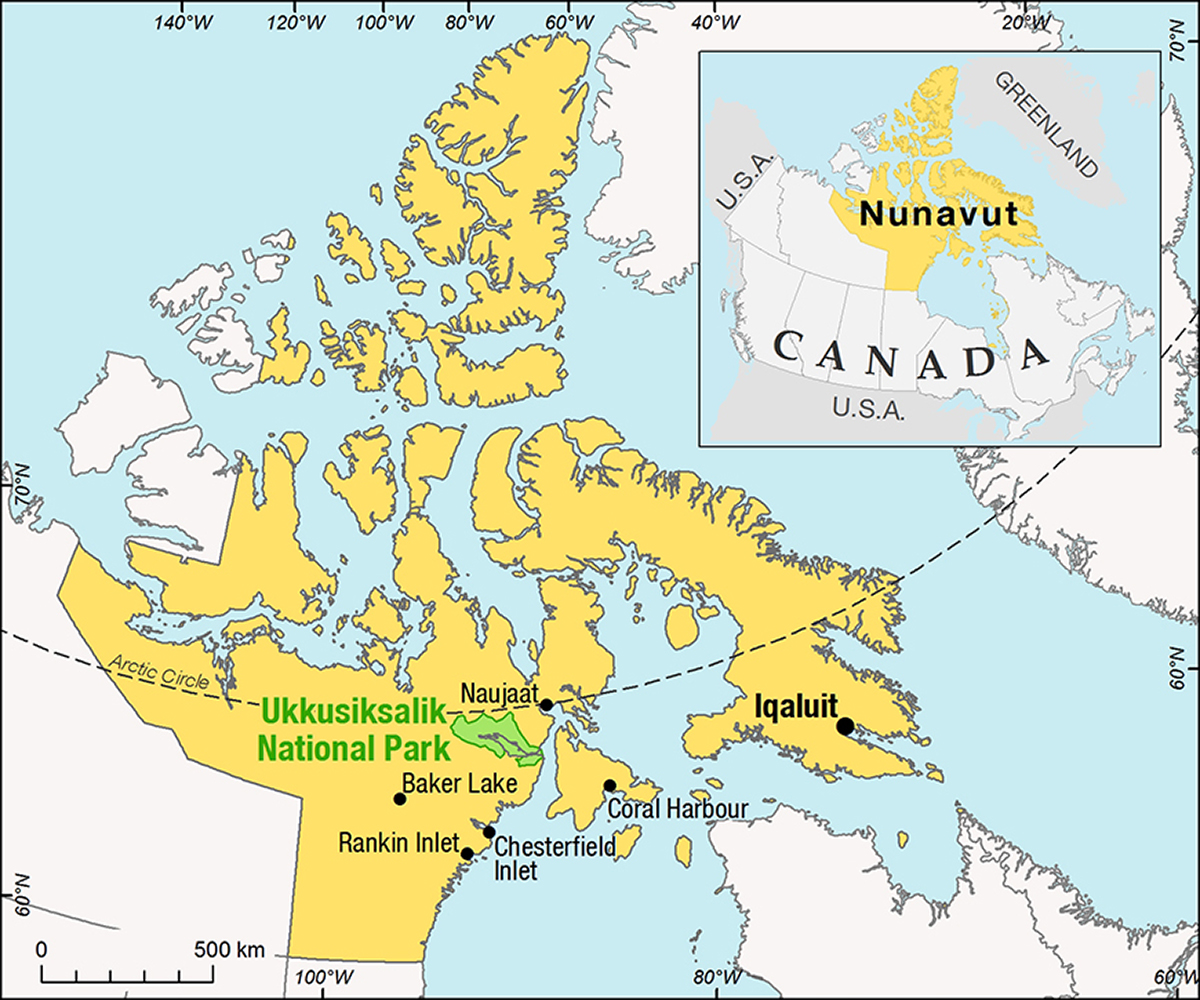
Map 2: Ukkusiksalik National Park
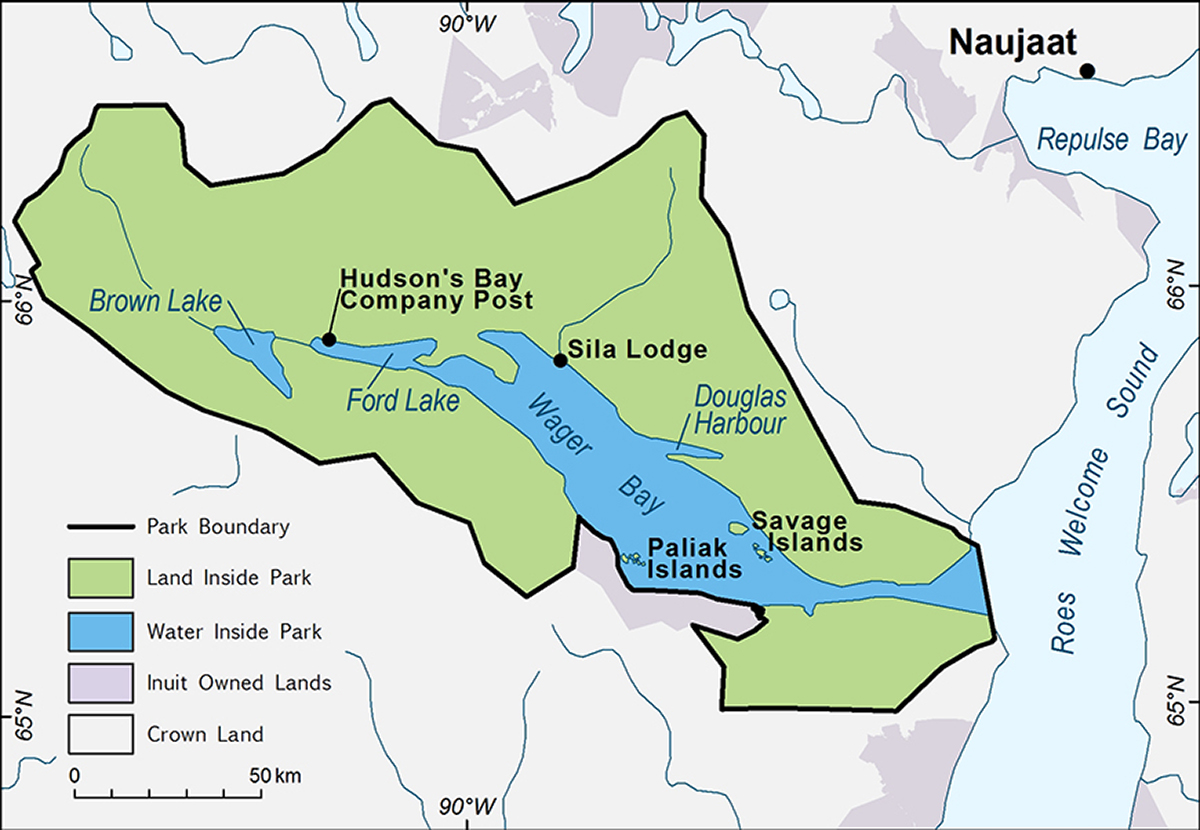
2.0 Significance of Ukkusiksalik National Park
The park was first proposed as a protected area in 1978, as part of the “6 North of 60” consultation programFootnote 1. It was the fourth national park established in Nunavut in accordance with Part 2 of Article 8 of the Nunavut Agreement. The park is representative of the Central Tundra natural regionFootnote 2. Lands were reserved for a national park in 1996 around Wager Bay, a veritable inland sea which extends more than 150 kilometers inland from Roes Welcome Sound on Hudson Bay to a set of reversing falls at the mouth of Ford Lake, the location of a former Hudson’s Bay Company trading post (Map 2). At 20 885 km2, Ukkusiksalik is among the ten largest national parks in Canada. “Ukkusiksalik”, an Inuktitut term, means “place where there is stone to carve pots and oil lamps”. Soapstone is used by Inuit to construct oil lamps which ensured survival and were used for heat, light, and cooking in the harsh Arctic conditions.
The first occupants of the Wager Bay area were nomadic groups affiliated with the Pre-Dorset culture (2000 BC – 800 BC) who later evolved into the Dorset culture around 800 BCFootnote 3. The first acknowledged inhabitants of the park were members of nomadic groups affiliated with the Thule culture which is known to have arrived in north-western Hudson Bay around 1200 ADFootnote 4. The people living in the area until recently are known as AivilingmiutFootnote 5. The park is dotted with at least four hundred and forty-nine known cultural resources which inform our understanding of the historic cultural heritage in this area (Table 1 includes significant cultural sites).
Low tundra vegetation superimposed on the Canadian Shield dominates the landscape. Wildlife found in the park includes polar bears, grizzly bears, muskox, caribou, wolves, wolverine, Arctic fox, Arctic hare, Arctic ground squirrel, peregrine falcons, gyrfalcons, golden eagles, rough-legged hawks, snow geese, Canada geese, tundra swans, and snow buntings, among others. Wager Bay is also known for seals, beluga, and Arctic char, and for impressive tides.
The park is jointly managed by Inuit and Parks Canada in accordance with the Nunavut Agreement and the IIBA. According to Article 2.2 of the IIBA, Ukkusiksalik National Park was established to:
- Protect a representative natural area of Canadian significance in the Central Tundra natural region so as to leave it unimpaired for future generations;
- Provide for the maintenance of vital, healthy, wildlife populations capable of sustaining Inuit harvesting needs;
- Celebrate the special historical and cultural relationship between Kivalliq Inuit and the land in the Ukkusiksalik National Park area;
- Encourage public understanding, appreciation and enjoyment of the Ukkusiksalik National Park Area; and
- Recognize and honour Inuit knowledge, culture and harvesting rights and incorporate them as part of the living legacy of the park.
3.0 Planning Context
The legal and administrative context of the park, broad trends that will affect the park in years to come, and perspectives of Inuit, adjacent community members, stakeholders, and other members of the public must be taken into account in management planning for the future of Ukkusiksalik National Park. Several issues and opportunities were identified in the State of the Park Assessment and pre-planning work including the challenge of current infrastructure deficiencies to support park operations and users, the opportunity for the park to play an important role in the protection and promotion of Inuit culture, and the need to collect more scientific and Inuit traditional knowledge for use in park management decisions.
3.1 The legal and administrative context of the park
In accordance with the Nunavut Agreement, the Inuit Impact and Benefit Agreement for Ukkusiksalik National Park of Canada was concluded and signed in 2003. Ukkusiksalik National Park was established in 2014 by order in council under the Canada National Parks Act, however, the park has been operating in the spirit of the Act since the IIBA was signed. The Nunavut Agreement defines Inuit rights and benefits and identifies cooperative management structure for national parks in Nunavut. In particular, articles in the agreement recognize the rights of Inuit to harvest wildlife, quarry carving stone, establish outpost camps, and to enter national parks at no cost.
The Nunavut Agreement (Articles 8.4.11-8.4.14) and the IIBA (Article 6) define the cooperative management approach for the park. The Ukkusiksalik Park Management Committee (UPMC) is the cooperative management body for the park. According to Article 5.5, the role of the UPMC is to advise Parks Canada, the Minister responsible for Parks Canada, the Nunavut Wildlife Management Board, and other agencies on all matters relating to the management of the park.
3.2 Early park development
Since 2003, many actions have been taken to establish a foundation for management. In 2007, an office and garage were constructed and staff housing units were also acquired in the community of Naujaat. Furthermore, considerable success has been made in hiring Inuit to manage the park. Several staff members have close, historic ties to the park, with one staff having been born there. A number of projects have occurred in the park including initiating cleaning up and stabilizing the former Hudson’s Bay Company post on Ford Lake and completing the first year of a two year project to conduct research to gather baseline data for Wager Bay. The official opening of the park took place in early July of 2015 at the same time that the Hamlet of Naujaat formally adopted its traditional Inuktitut place name. Finally, in 2017, the first joint review of the IIBA for Ukkusiksalik was completed and the results of this review have been considered in the development of this plan.
3.3 The relationship with the park’s adjacent communities and tourism opportunities
Inuit maintain a strong relationship with the land and marine environments in which they live. Inuit who live in the communities of Baker Lake, Chesterfield Inlet, Coral Harbour, Naujaat, and Rankin Inlet continue to travel extensively for their way of life, including within the park. Inuit Qaujimajatuqangit is vital to understanding the park’s ecosystems and enhancing Inuit connections to the park.
Rankin Inlet is the Kivalliq region’s largest community and is a transportation and logistics hub. In addition to government services, the mining industry has a strong presence in Rankin Inlet and across the Kivalliq region, including areas surrounding the park.
Together with the Thelon and Kazan Heritage Rivers, the park has the potential to be a major tourism attraction in the region. Since establishment, the park has seen very few visitors due to a number of factors including the remote nature of the area, the short season for tourism, and the lack of tourism operators and infrastructure in adjacent communities. A naturalist lodge operated on the shores of Wager Bay for around fifteen years from the late 1980s to the early 2000s on lands leased from Indigenous and Northern Affairs Canada and attracted hundreds of visitors from around the world. The lodge has not operated for approximately 10 years. In order to demonstrate its long term commitment to the development of sustainable tourism, and in order to fulfill the requirements of Article 12.5 of the IIBA, Parks Canada commissioned a tourism strategy as the key to expanding visitation to the park and enhancing the benefits of the presence of the park to Inuit and Inuit businesses in the park’s adjacent communitiesFootnote 6.
Due to the park’s remote location, the cost of accessing it, and the lack of infrastructure, few non-Inuit visit the park. Current park visitation has been very low, with a total of seven visitors since the 2014-2015 fiscal year. Cruise ship visitation to Nunavut has increased steadily since 2006 and research indicates it will continue to expand, however, Wager Bay and the park have not been identified as desirable destinations for the industry. Concerns have been raised about cruise ships by the UPMC because of the dangers associated with navigating in Wager Bay and the potential to disrupt both Inuit, during traditional harvesting activities, and wildlife, including polar bears and marine mammals. Increasing high-end private sailboat, yacht, and luxury cruise ship visits indicate new niche market potential, however Wager Bay and the park will likely only remain a curiosity until more nautical information about the area is available to sailors.
Visitor access to the park by aircraft has taken place, but it has significant potential to expand visitation, especially during the ice break-up period when overland access will not be possible.
The park provides some protection for species and ecosystems, but many Arctic species such as caribou, polar bears, sea birds, and marine mammals range far beyond the boundaries of the park and are not isolated from global pressures. These pressures are changing the entire Arctic and are impacting the lives of Inuit who live there. The ecosystem monitoring program is in place to identify any changes in the integrity of the components of the park’s ecosystems.
4.0 Vision
The vision for Ukkusiksalik National Park was developed through a workshop involving members of the UPMC, the Park Planning Team, and Parks Canada staff. This vision reflects the desired state of Ukkusiksalik National Park in 15 to 20 years.
Ukkusiksalik National Park is a landscape alive with the stories of generations of Inuit, abundant wildlife, and striking vistas. The park is a beautiful place that feeds our imagination, our souls, and our bodies. Fully immersing oneself into the park will ensure the creation of long lasting memories, connecting you to a land that will never be described as empty and that must always remain a place to escape to.
Ukkusiksalik will be a place where the Inuit way of doing things: past, present, and future knowledge, experiences and values, that-is-to-say “Inuit Qaujimajatuqangit” is protected, promoted, and passed on. Families strengthen their connections to the land. Inuit elders share the skills they learned from their ancestors. Stories are brought to life and passed on as they have been passed on for generations.
Ukkusiksalik will continue to be managed jointly by Inuit and Parks Canada. Management will be based on Inuit Qaujimajatuqangit and science to promote ecological integrity including healthy wildlife populations that are able to follow their natural cycles. Plants that provide food and medicine will be plentiful. Ukkusiksalik will fulfill its destiny as a northern paradise and a true Arctic wilderness for all to experience the mystery now and in perpetuity.
5.0 Key Strategies
The management of Ukkusiksalik National Park takes the form of three key strategies, each with a set of corresponding objectives and targets. Objectives are mutually supportive and address the needs of a new national park to be better known, valued, and enjoyed by Canadians and by visitors from around the world while building a relationship between Parks Canada and Inuit of Baker Lake, Chesterfield Inlet, Coral Harbour, Naujaat, and Rankin Inlet.
Key strategy 1:
Infrastructure – Ensuring that appropriate facilities are available for protection, presentation and promotion of Ukkusiksalik National Park
Ukkusiksalik is located in a beautiful, but unforgiving landscape. The abundance of polar bears and severe weather conditions dictate that those who visit or work in the park must have hard-sided shelters available to them. Furthermore, the remote nature of the park warrants a base of operations for park staff to fulfill their duties. By implementing this management strategy, facilities will be designed and constructed or secured to fulfil the needs of multiple user groups and ensure safety.
Parks Canada will work with stakeholders and partners to design and construct or secure facilities which benefit Inuit, visitors, researchers and other agencies, and park staff while minimizing the impacts to the park’s natural and cultural features. Green infrastructures will be considered.
The strategy addresses the following priorities and IIBA commitments:
- Developing hard-sided shelters to ensure the safety of all park users (Article 10.1), and
- Developing and providing safety information for park visitors and users in several of the park’s adjacent communities (Article 9.3.5).
Objective 1.1
A base of operations and hard-sided shelters are available in the park.
Targets:
- A plan to determine the vision and requirements for a base of operations for the park, identifying infrastructure and asset needs, including the need for and availability of hard-sided shelters, is completed within two years.
- The infrastructure development plan is ready to be implemented within four years, depending on location, size, complexity, and features of the structures.
- Hard-sided shelters are available for park users and visitors within eight years dependent on size, complexity, integration with existing structures, and features of the structures. Priority locations may include, but are not limited to: near the site of the Hudson’s Bay Company post, in Douglas Harbour, in the area of Sila Lodge and east of the reversing falls at Iglujuarnaq.
Objective 1.2
Access routes and points, safe harbours, sensitive sites, and other features are identified and communicated to park users.
Targets:
- Access routes, landing sites, safe harbours, emergency shelters, equipment caches, sensitive sites, and other features of interest are identified within two years to support visitor experience development and delivery and for educational and promotional purposes. New, pertinent information will be incorporated into these products as required.
- Displays are installed in Baker Lake, Naujaat, and Rankin Inlet to promote the park, inform park users and provide interpretation products in accordance with Article 9.3.5 of IIBA.
Key strategy 2:
Living landscape – Strengthening people’s connections to Ukkusiksalik National Park
This strategy focuses on recognizing historic and existing connections between Inuit and the park. The historic connections people have to the Wager Bay area is a critical part of the story of Ukkusiksalik National Park to be told.
The strategy addresses the following priorities and IIBA commitments:
- Develop Ukkusiksalik National Park’s visitor experience (Article 2.2.4, 2.8, 9, and 10);
- Respect Inuit harvesting and cultural activities while balancing visitor experience (Article 1.1.2, and Article 3); and
- Promote Ukkusiksalik National Park as a major attraction in the region, across the territory, and nationally (Article 9).
Objective 2.1
Inuit connections to Ukkusiksalik National Park are strengthened and shared.
Targets:
- Deliver outreach programs in two communities annually.
- Create opportunities for Inuit to use the park area and to share Inuit Qaujimajatuqangit.
- Develop and deliver outreach programs or products encouraging land stewardship for the park’s adjacent communities.
- Create at least one student position within one year and staffed annually by students from one of the park’s adjacent communities.
- Strengthen the capacity of UPMC through mentoring and the delivery of training opportunities during each member’s mandate.
- Develop an annual patrol for park monitoring and asset condition assessment with a task schedule within one year, and the first patrol is implemented beginning in the spring following the approval of the plan.
Objective 2.2
Opportunities for park visitors to experience the landscape and hear the stories of Ukkusiksalik.
Targets:
- Interpretive products or experiences are developed to tell the story of Ukkusiksalik National Park’s important cultural sites including but not limited to the Hudson’s Bay Company post, and Ak&ungitautitalikFootnote 7 (rope game site) within five years.
- Site specific standards and mitigation measures for visitors are developed and communicated to park users for the park’s important cultural sites within two years.
- Wildlife viewing guidelines are developed and communicated to park users within two years.
- An online digital tool to promote and present the park through virtual visits is launched within the first four years.
- Three in-park visitor experience opportunities developed, as information is gathered from all sources, including Inuit Qaujimajatuqangit, Inuit Knowledge Working Group and science, and implemented within the ten year scope of this management plan.
Key strategy 3:
Gathering knowledge – Collecting scientific information and Inuit Qaujimajatuqangit in support of protecting, presenting and promoting Ukkusiksalik National Park’s natural and cultural resources
This strategy prioritizes the collection of scientific information and Inuit Qaujimajatuqangit in order to understand, protect and promote the cultural and natural heritage values of Ukkusiksalik. This information will be used to establish benchmarks for the long term monitoring of natural and cultural resources in the park, and to better share the park’s stories.
The strategy addresses the following priorities and Inuit Impact and Benefit Agreement commitments:
- Protect the park’s environment and provide for the maintenance of vital, healthy, wildlife populations capable of sustaining Inuit harvesting needs (Article 2.2.2);
- Protect historical and archaeological resources of the park (Article 7);
- Promote and conduct research in the park (Article 8); and
- Clean up the site of and stabilize the Hudson’s Bay Company Post for use in the interpretation of the park’s stories (Article 12.6.4).
Objective 3.1
Scientific information and Inuit Qaujimajatuqangit are collected to determine the current health of Ukkusiksalik National Park’s ecosystems and to detect changes in the future.
Targets:
- Establish and implement a marine ecosystem monitoring program within three years.
- Establish and implement a terrestrial (tundra) ecosystem monitoring program within three years.
- Complete baseline data collection, within seven years, to aid in future follow-up program related to the potential effects on the ecosystems of industrial development in areas adjacent to the park.
- Include at least one Inuit knowledge measure in the monitoring program.
Objective 3.2
Scientific information and Inuit Qaujimajatuqangit are being used to inform and support long term management decisions.
Targets:
- A framework for the Ukkusiksalik Inuit Knowledge Working Group guiding how Inuit Qaujimajatuqangit can provide input into management decisions will be developed within two years of approval of this plan.
- Continue to collect, record, and share Inuit Qaujimajatuqangit and elders’ stories about Ukkusiksalik National Park.
- An outreach program targeting researchers with the goal of encouraging future research is developed and implemented within three years.
- Research priorities are reviewed with input from the UPMC within two years.
- Information on caribou, polar bear, and raptor populations is updated before the next State of the Park Assessment in collaboration with other agencies and Inuit knowledge holders to identify ecologically and biologically sensitive areas in the park.
- Information to implement the fishing prohibition in Article 10.8 of the IIBA is collected to correspond with the enactment of the updated National Parks of Canada Fishing Regulations.
Objective 3.3
Progress has been made towards identifying and protecting the cultural resources that tell Ukkusiksalik National Park’s story.
Targets:
- The Hudson’s Bay Company post stabilization and development of an interpretive program in accordance with Article 12.6.4 of the IIBA is fully implemented within five years.
- A monitoring program for any of the park’s cultural resources deemed at threat is created and implemented within five years.
- Progress is made to continue detailed inventories of important cultural sites based on information gathered from traditional knowledge holders (e.g. five sites during the life of this plan).
- Increase knowledge of traditional travel routes and Inuktitut place names for the park within seven years.
6.0 Zoning and Areas of Special Importance to Inuit
6.1 Zoning
Parks Canada’s national park zoning system is an integrated approach to the classification of land and water areas in a national park and designates where particular activities can occur on land or water based on the ability of those areas to support those uses. The zoning system has five categories:
- Zone I - Special Preservation
- Zone II - Wilderness
- Zone III - Natural Environment
- Zone IV - Outdoor Recreation
- Zone V - Park Services
Ukkusiksalik National park has three zoning classifications including zones I, II, and III (Map 3). The Nunavut Agreement requires that national parks in the Nunavut Settlement Area predominantly consist of Zone I and II areas. The zoning system does not apply to resource harvesting activities and subsistence use by Inuit when these activities are being carried in accordance with the Nunavut Agreement.
The IIBA does not identify specific needs for areas within the park to be identified as Areas of Special Importance to Inuit, however two such areas were identified during consultations with Inuit (see 6.2 Areas of Special Importance to Inuit).
Important cultural sites, which are deemed critical to telling the story of Ukkusiksalik National Park were assigned a Zone I designation. These sites are expected to be used to tell the story of the park and control visitation. Some activities, with conditions and mitigations, will be permitted in those sites.
Polar bear denning areas, colony nesting areas for migratory birds, and caribou calving habitat have been designated as Zone II areas with seasonal closures. These important habitat areas will be managed with strict controls to support wildlife conservation.
At the time this management plan was written, the results of the Marine Baseline Project had not yet been fully processed. It is expected that some of the information collected during this project could help further refine the zoning in Wager Bay. During the life of this plan, the zoning for Wager Bay may be changed to reflect any sensitive or important feature discovered during the analysis of the information collected during the Marine Baseline Project. In the interim, tools such as Superintendent’s Orders, Area Closures, and impact assessment will be used to address issues identified in the results of the project.
Map 3: Ukkusiksalik National Park Zoning
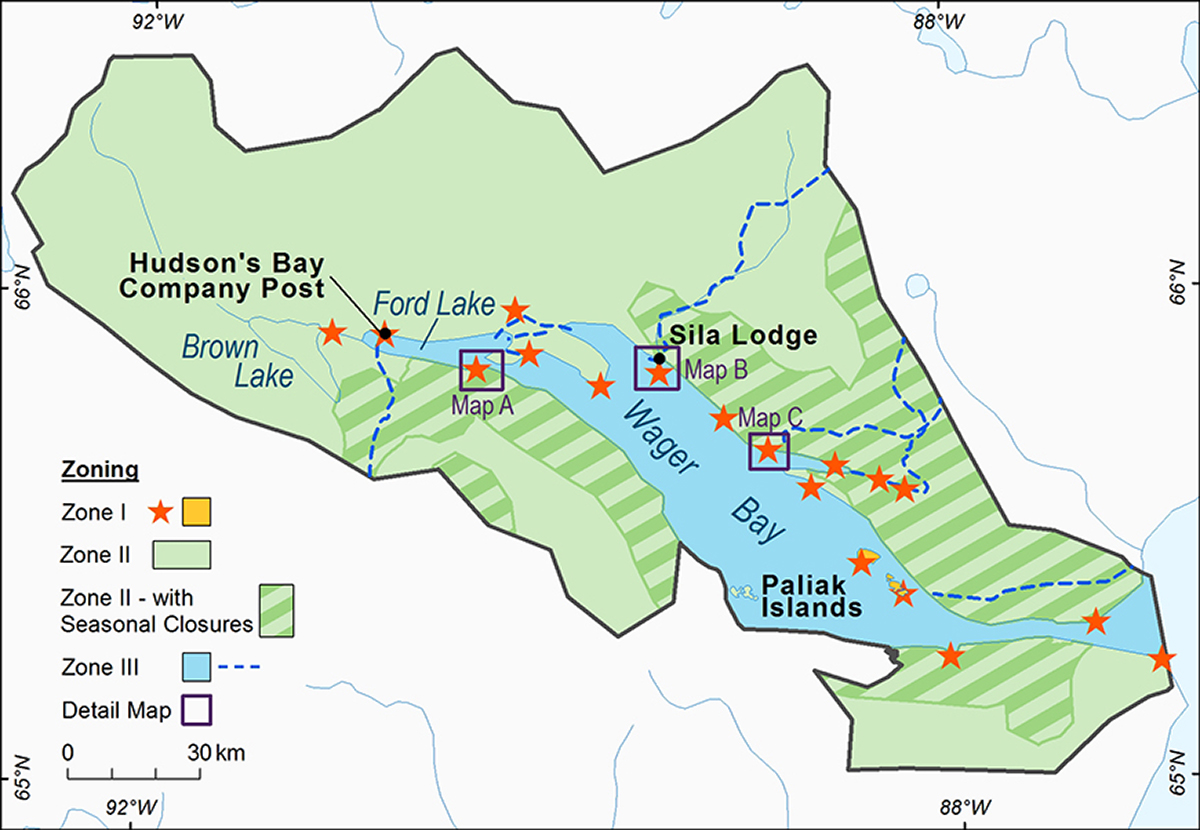
Zone I: Special Preservation – Significant cultural resources
Zone I sites require special protection because they contain or support unique, sensitive, threatened or endangered natural or cultural heritage features, or are among the best examples of the features of the natural region represented by the park. Visitation to Zone I sites may be authorized under carefully controlled and monitored conditions. Motorized access is not permitted, except for strictly controlled motorized access for research and park operation activities authorized by Parks Canada.
Several important cultural resources have been identified in the park that, if disturbed, would impede the ability of Parks Canada to tell the story of Ukkusiksalik. Of the approximately 449 known cultural sites in the park, 37 have been recognized as being important in this sense. As more research takes place in the park, it is expected that this selection could change. Respecting the integrity of these and all of the park’s cultural resources is important. As such, Special Preservation zoning has been applied using buffers of varying sizes to a selection of these sites. Site specific guidelines are being developed to prevent disturbance for each resource.
No camping activities are allowed within the buffers identified for Zone I sites of cultural significance.
In addition to general archaeological and historical investigations, priority will be placed on the cultural resources which have been deemed to be rare, sensitive, and unique within the parks (Table 1).
| Site Name and/or Location | Site IDs | Description | Buffer Size (km) |
|---|---|---|---|
| Ak&ungitautitalik * | 70X249 | Site of the Rope Game | 1.0 |
| Wager Bay Inlet Hudson’s Bay Company Post and associated sites** |
70X331 |
Former HBC Post | 1+ (irregular) |
| 70X332 | Campsite | ||
| 70X461 | Wager Inlet site | ||
| 70X330 | Campsite | ||
| 70X521 | Wolf trap remains | ||
| 70X518 | Burial site | ||
| 70X462 | Campsite | ||
| Nuvukliit*** Island Archipelago | 70X222 | Catholic Mission | 1+ (irregular) |
| 70X237 | Main Savage Island | ||
| 70X223 | Nuvukliit Island | ||
| Former Hudson’s Bay Depot site/Iglujuarnaq | 70X403 | Tundra Vehicle A | 0.5 |
| 70X404 | Iglujuarnaq | 1.0 | |
| Lower Piksimanik River | 70X360 | Falcon Pinnacle | 1.0 |
| 70X259 | Sakamoqtoq | 0.5 | |
| Reversing Falls habitation sites | 70X467 | Campsite | 1.0 |
| 70X471 | Reversing Falls | 1.0 | |
| 70X78 | Campsite | 0.5 | |
| Tinittuktuq Point | 70X1 | Point A | 1+ (irregular) |
| 70X2 | Point B | ||
| 70X3 | Point C | ||
| 70X4 | Point D | ||
| 70X505 | Campsite | ||
| 70X516 | Campsite | ||
| 70X506 | Burial site | ||
| Sila River Bluffs | 70X305 | Sila River Bluffs A | 0.5 |
| Douglas Harbour, north shore | 70X270 | Douglas Harbour Site, across from Tikilak Point | 1.5 |
| 70X513 | Campsite | 1.0 | |
| 70X266 | Campsite | 0.5 | |
| Tijiarjuaq Peninsula | 70X52 | Tijiarjuaq Peninsula | 1.0 |
| Mattok | n/a | The remains of the George Cleveland Whaling Station | 2.5 |
| Qaurnak Winter House | 70X318 | Qaurnak Winter House site | 0.5 |
| Brown Lake | 70X338 | Brown Lake | 1.0 |
| Cape Dobbs | 70X151 | Cape Dobbs | 1.5 |
| Kuugarjuk Creek | 70X280 | Creek A | 5.0 |
| 70X281 | Creek B | 5.0 | |
| Handkerchief Inlet/Kangirsuarjuk | n/a | Shipwreck of the Jeanie and the remains of RCMP Patrol House #3 | 5.0 |
** Visitation to Hudson’s Bay Post has been identified as a potential site for visitor experience within the IIBA and will be open for visitors under specific guidelines. Visitors to this area must be accompanied by an approved guide and/or Parks Canada staff member.
*** Nuvukliit, historically, has alternate spelling due to translation from Inuktitut to English. Alternate versions included in the Ukkusiksalik National Park Management Plan are Nuvudlik and Nuvuk&iit.
Zone II: Wilderness – Park wilderness areas
Zone II contains extensive areas that are good representations of a natural region and are conserved in a wilderness state. The perpetuation of ecosystems with minimal human interference is the key consideration. Zone II areas offer opportunities for visitors to experience firsthand the park’s ecosystems and require few, if any, rudimentary services and facilities. In much of Zone II, visitors have the opportunity to experience remoteness and solitude. Motorized access is not permitted except strictly controlled motorized access for research, park operations and outreach and education activities relating to the park that are authorized by Parks Canada and are consistent with Parks Canada regulations and policy.
Ukkusiksalik National Park is a vast wilderness known for its abundant animal and plant life that have sustained Inuit for generations. The zoning as wilderness area and associated closures, reflect the requirement for conservation of the natural features of the park while also addressing the temporary nature of the need for protecting wildlife and associated habitat (Map 4). As is required by the Nunavut Agreement the majority of the park falls within this designation. The only areas not included into the Wilderness Zoning are those listed above as important cultural sites and those areas listed below as park access routes and landing zones (Map 5).
Important natural features in Ukkusiksalik National Park for which a greater degree of protection (for which time bound closures have been prescribed) is warranted include the following:
- Caribou calving areas (seasonal closure mid-May to July 1). The season may shift over the life of this management plan, based on updated information. Entry into caribou calving areas during the identified calving season is prohibited, including Zone 3 access routes that transit these areas.
- Polar bear denning areas (seasonal March 1 to July 1). The season may shift over the life of this management plan, based on updated information. Entry into denning areas is prohibited, including Zone 3 access routes that transit these areas.
- Guillemot, eider duck, and other nesting colonies (seasonal closure while birds are present on the nests). Park visitors may only observe colonies from a distance and must respect Environment and Climate Change Canada’s Canadian Wildlife Service’s guidelines for avoiding disturbance to seabird and waterbird colonies, including maintaining appropriate buffer zones around colonies.
Map 4: Zone II Wilderness and Seasonal Closures
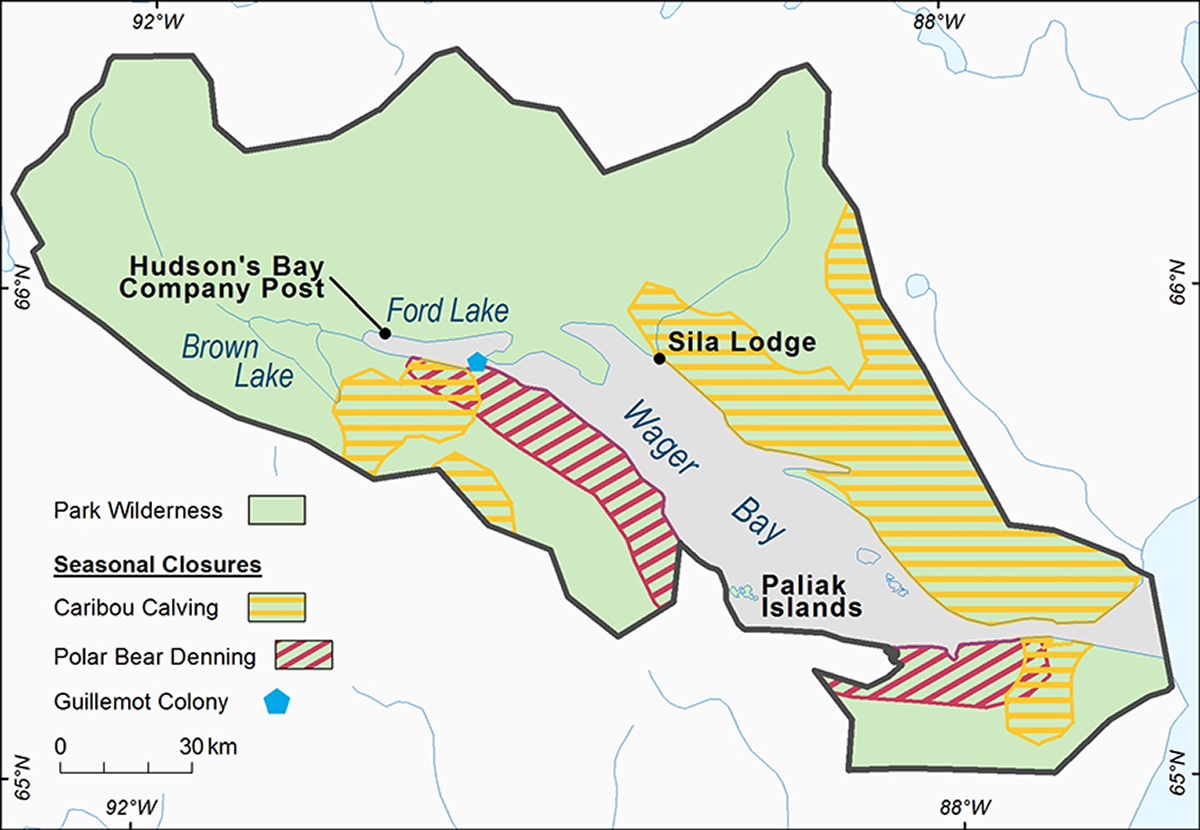
Map 5: Park Access Routes and Landing Zones
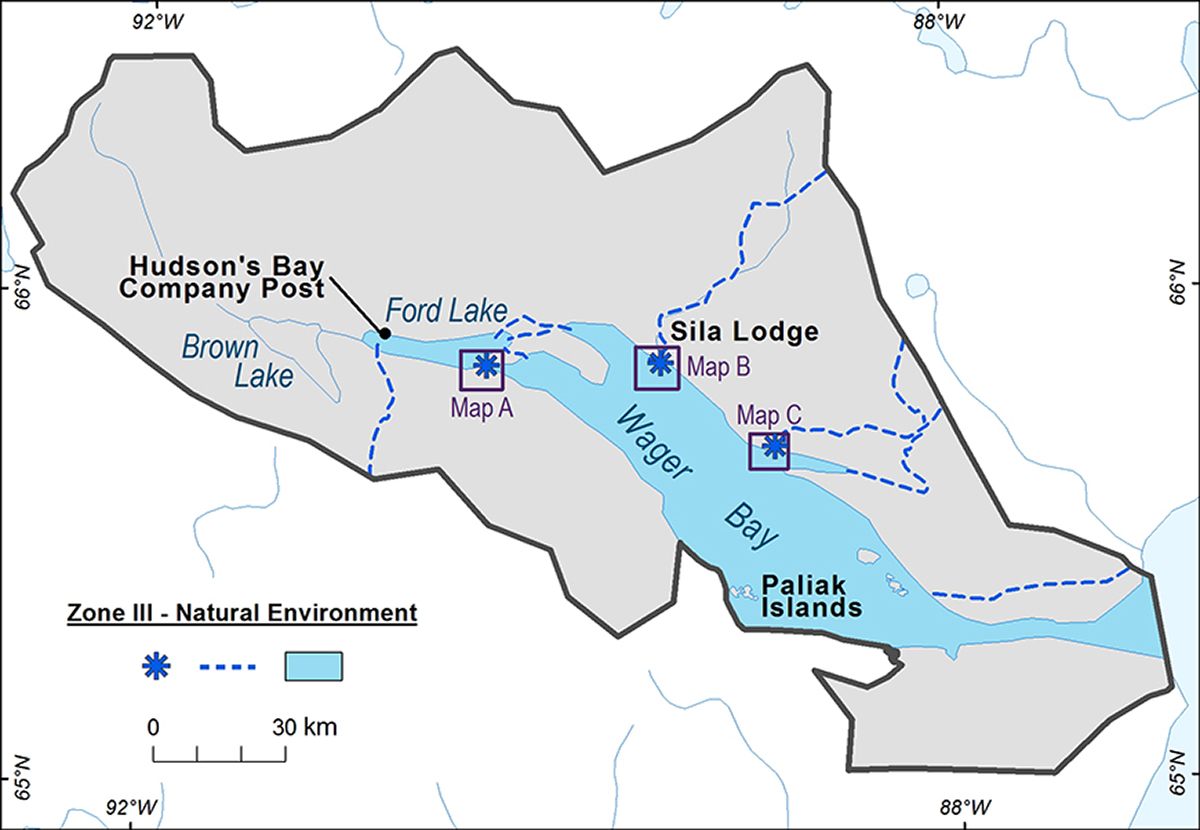
Zone III: Natural Environment – Park access
In Zone III areas, visitors can discover the park’s natural and cultural heritage through recreational activities that require a few rustic services and facilities. Motorized access will be permitted to specific, controlled areas only.
In order to facilitate visitation to the park, several areas of the park have been designated as Zone III Natural Environment. This designation allows the use of motorized means of transportation. Given the remote nature of the park, these areas are important in order to allow outfitters and visitors to enter the park and access key jumping off points for visits. At this time, four over snow routes, Wager Bay and two aircraft landing zones have been identified in the park (Map 5). Furthermore the IIBA includes a clause that permits access through the park for potential mining and thus zoning would have to be revisited to potentially support this potential project.
Over-Snow Routes
- Sila River route
- North Piksimanik route
- South Piksimanik route
- Ford Lake route
Motorized access over land is only possible during the winter months as there are no roads in the area. Three routes were identified originating from Naujaat and one originating from communities south of the park. As it is the case in other parks in Nunavut, only trips led by outfitters and Park Canada employees will be allowed to use over snow vehicles to access the park. New routes may be permitted in the future. Travel through caribou calving and bear denning areas during the identified season will be prohibited.
Wager Bay and Ford Lake
- Wager Bay – Ford Lake Access
Currents at the mouth of Wager Bay have been recorded at up to eight knots. The tides in the bay are said to be comparable in magnitude to Frobisher Bay in Nunavut and are impressively high. Entry into the park from Roes Welcome Sound into Wager Bay is possible although a high degree of knowledge of the tides and currents is needed to navigate into the park safely. Access by smaller watercraft into Ford Lake is allowed via a specific channel that has been designated as a Zone III. Navigating this channel through the reversing tidal rapids at the entrance to Ford Lake is dangerous and is not recommended to unguided visitors (Map A).
Map A: Ford Lake Access Channel
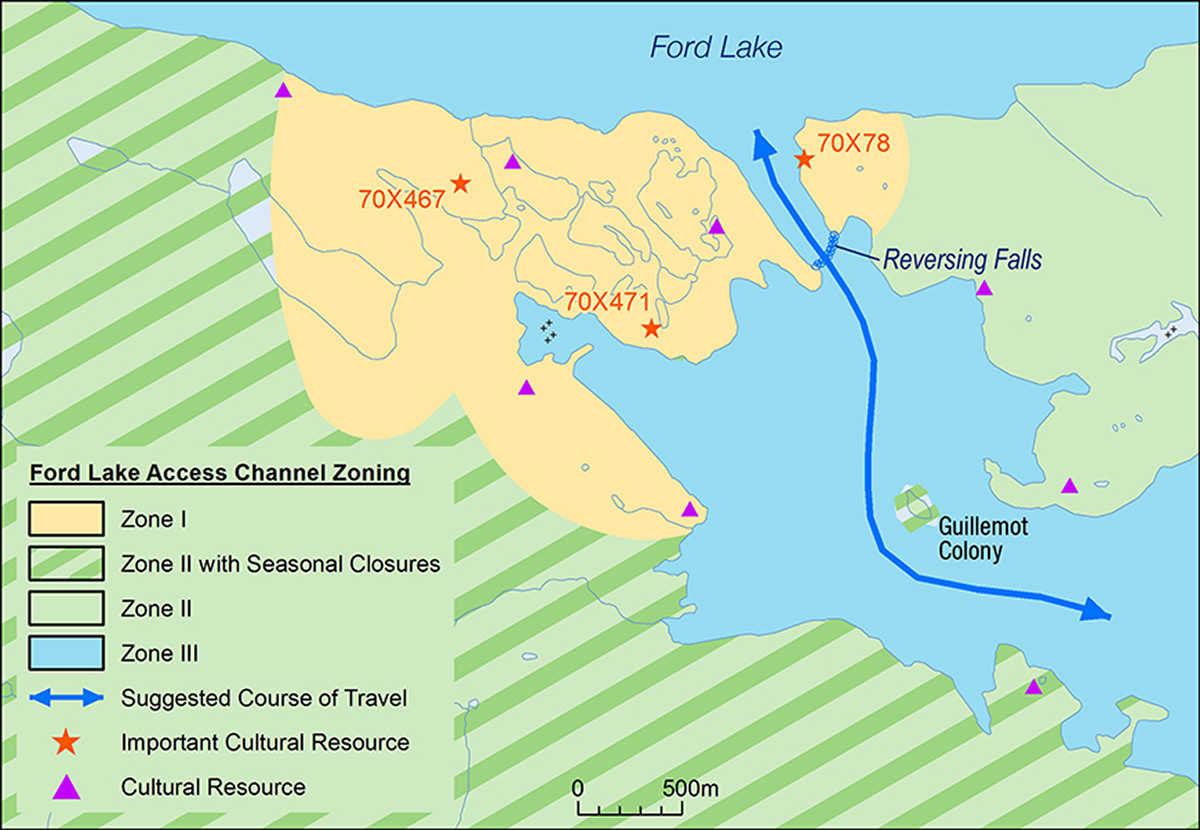
Aircraft Access
- Sila Lodge aerodromeFootnote 8
- Ford Lake aerodrome
Aircraft access to designated landing sites within the park will be permitted. In cooperation with the Inuit, and local organizations, Parks Canada will work with the UPMC to identify any new landing sites. Selected sites will minimize potential impacts on natural and cultural resources, Inuit exercising harvesting rights, and other parks users, while optimizing visitor experience. The intent is not to develop or maintain landing strips in the park, but to identify helicopter landing sites or places where fixed-wing aircraft have safely landed in the past. Landing sites outside the park on Inuit Owned Lands and Crown lands should also be considered, in discussion with the appropriate authorities.
Two areas in the park were identified as accessible to fixed-wing aircraft. These areas are: the existing landing strip at Sila Lodge, and summer floatplane access at Ford Lake. On-ice landings may be possible at these locations. All aircraft landings in the park must be authorized by Parks Canada in accordance with the regulations.
Sila Lodge Zone III Buffer
When the park was established two leases managed by Indigenous and Northern Affairs Canada were excluded from the lands transferred to the park. These leases are occupied by a former naturalist lodge. Natural environment zoning has been placed around these leases, giving the operators of the lodge the opportunity to resume operating as they have historically (Map B).
Map B: Sila Lodge Zone III Buffer
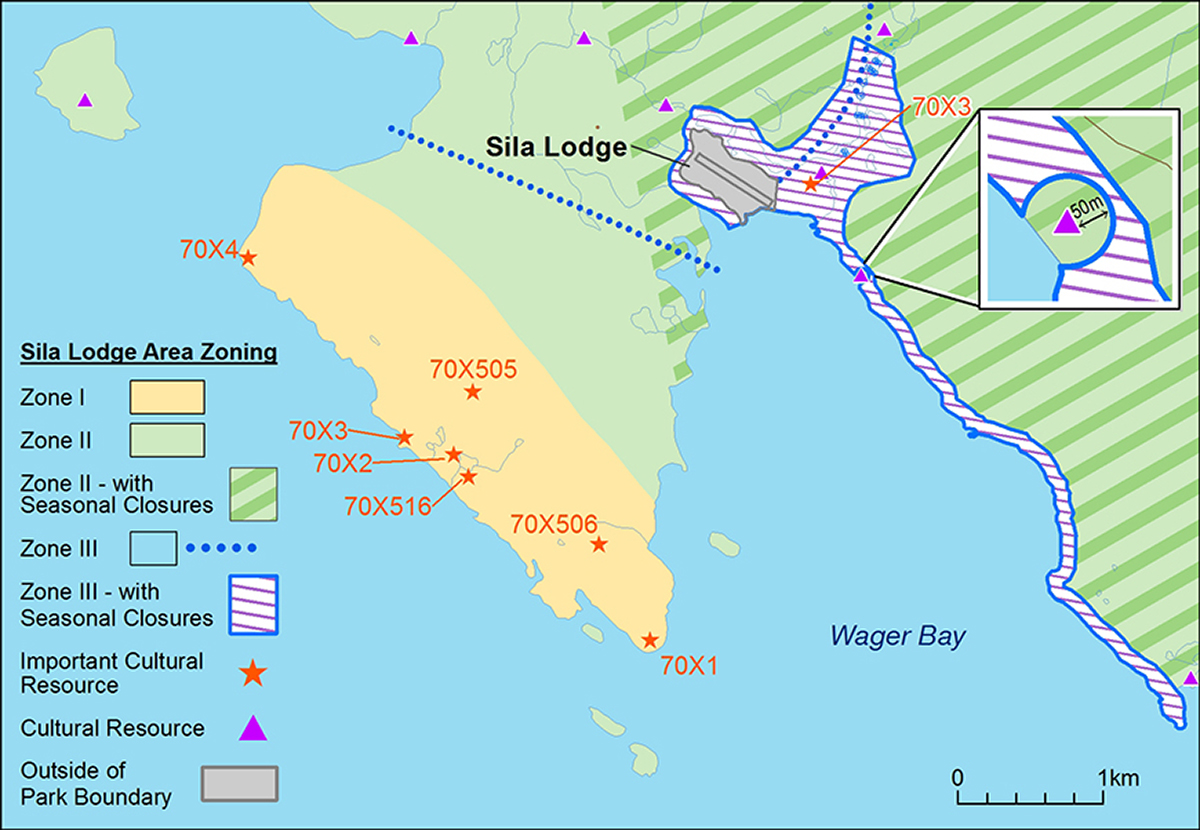
Douglas Harbour Zone III
When the park was established, the Government of Nunavut Department of the Environment had a research cabin located in Douglas Harbour in Wager Bay. The continued existence of a facility at this location is important for monitoring of wildlife populations by the Department of the Environment. Furthermore, the location is used by Inuit taking part in traditional harvesting activities or travelling in the park. Natural environment zoning has been placed around the existing site. Additional space in the zone has been added to allow for limited expansion of the infrastructure at the site to support future park operational activities, if required (Map C).
Map C: Douglas Harbour Zone III
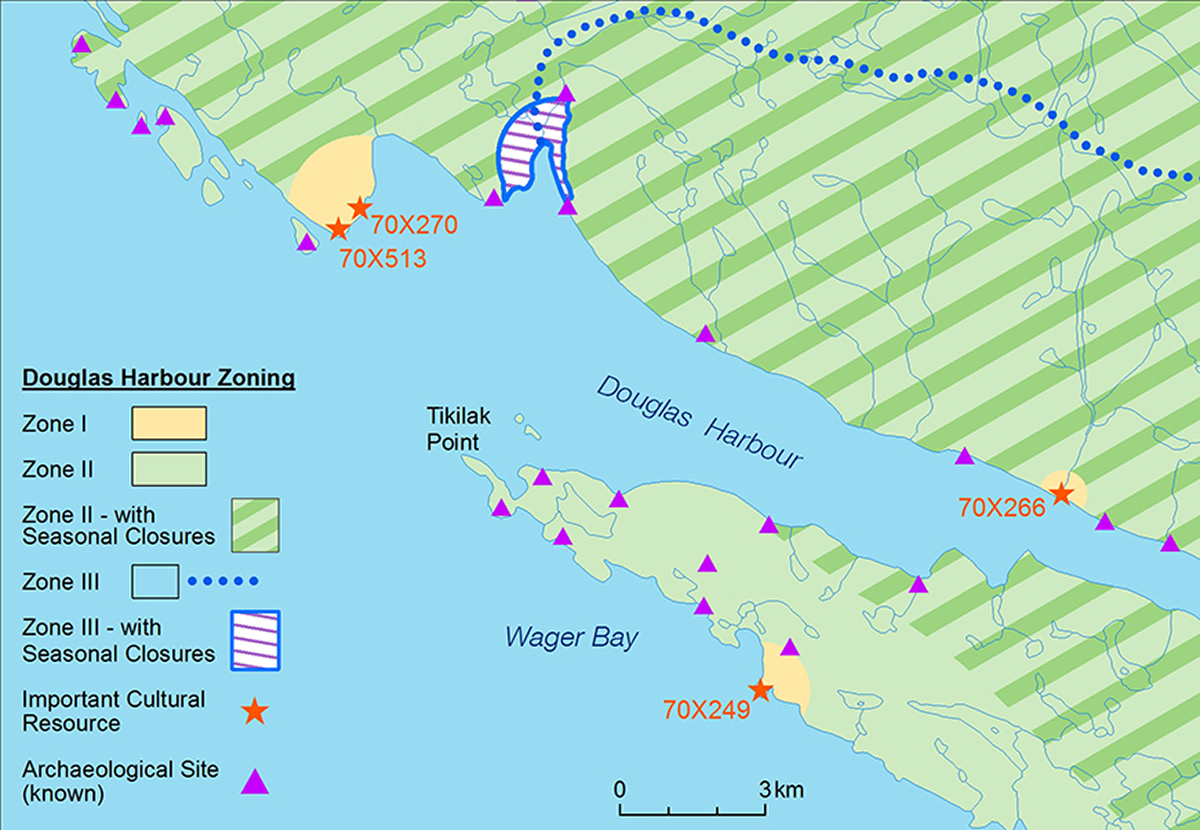
6.2 Areas of Special Importance to Inuit
The intent of designating a portion of a national park as an Area of Special Importance to Inuit is to maintain its character for Inuit who may still use those areas as they have done historically prior to the establishment of the park and in recognition of Schedule 6-1 of the Inuit Impact and Benefit Agreement for Ukkusiksalik National Park of Canada which states that “Inuit are an integral part of the ecosystem”. Indeed, the absence of Inuit in the ecosystems of Ukkusiksalik National Park would represent a failure of the Agency in maintaining ecological integrity. Restrictions on visitation to Areas of Special Importance to Inuit can be put in place, however no such recommendations were made at this time in the case of the two areas identified for the park (see Map 6).
In Ukkusiksalik National Park, the following have been declared as Areas of Special Importance to Inuit:
Map 6: Areas of Special Importance to Inuit
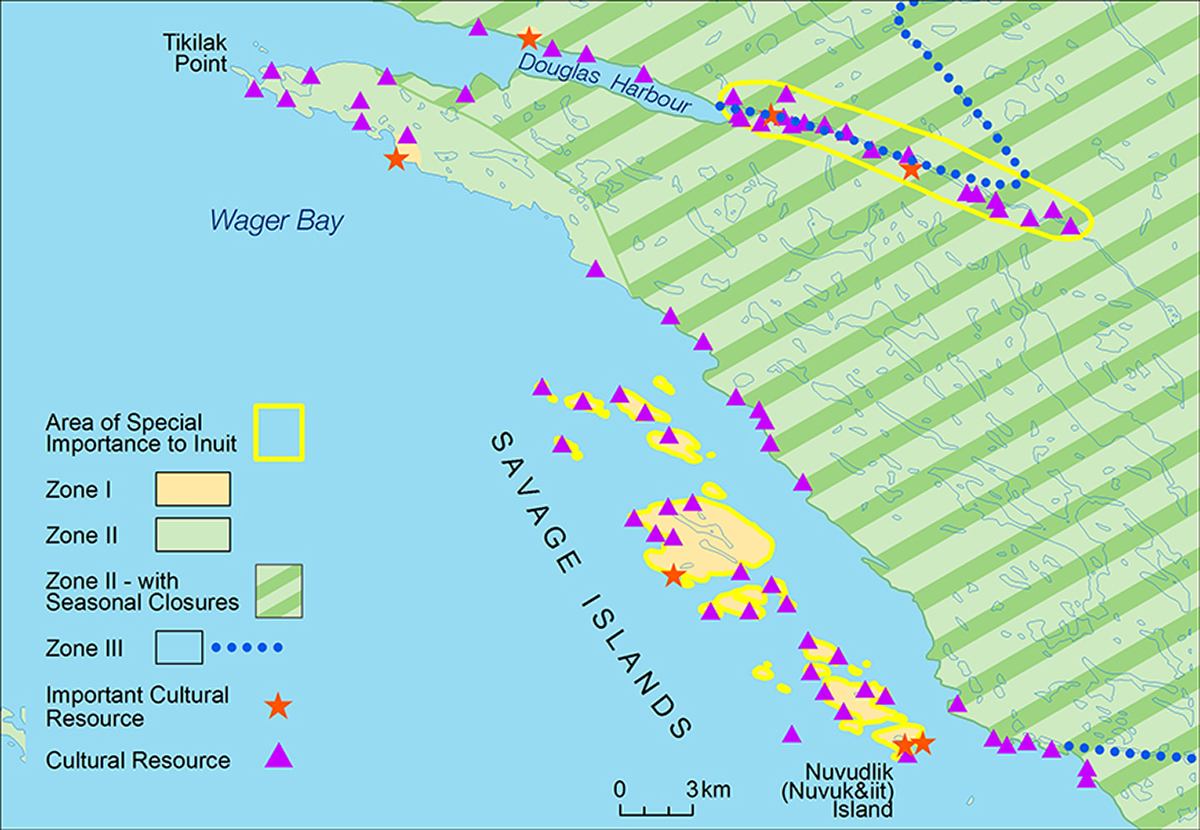
Lower reaches of the Piksimanik River
This area was an important seasonal habitation area and was traditionally inhabited by Inuit until they were forcefully relocated into modern communities only a few decades ago, however the areas were important at different times during the year for generations prior. Numerous cultural sites, including sod houses, tent rings, caches, soap stone quarries, and fish weirs are located in this area.
The Savage Islands
This grouping of islands located inside Wager Bay was an important habitation area and is also the location of the Nuvudlik Island Catholic mission. Inuit inhabited these islands during the winter months due to their proximity to a polynya and its associated floe edge.
6.3 Visitor Safety Restrictions or Closures
A Superintendent’s Order is currently in place compelling all visitors to register and de-register from the park. This measure is in place due to the inherently hazardous nature of park use in Nunavut and to ensure park staff are able to respond to an emergency should one occur.
6.4 Recreational Fishing by Visitors
Currently, Parks Canada does not have a conservation concern with fish populations in the park. According to Inuit, there are places in the park where Arctic char are abundant and have been harvested for many generations.
Angling by non-Inuit for recreational purposes will be authorized under a Parks Canada fishing permit, once the National Parks of Canada Fishing Regulations (C.R.C., c. 1120) have been updated to include Ukkusiksalik National Park. Restrictions may be set on the number and species of fish that may be caught per person per day. In the park, limits placed on personal catch may mirror the territorial regulations for the areas surrounding the park. Moreover, for potential recreational fishing, it is the desire of the Ukkusiksalik Park Management Committee that any fish caught be kept (for consumption) and not live-released. Further recreational fishing management proposals include: catch and possession limits of four fish per day per person and sport fishing prohibitions in areas (Map 7) with commercial fishing quotas.
Map 7: Commercial Fishing Quotas
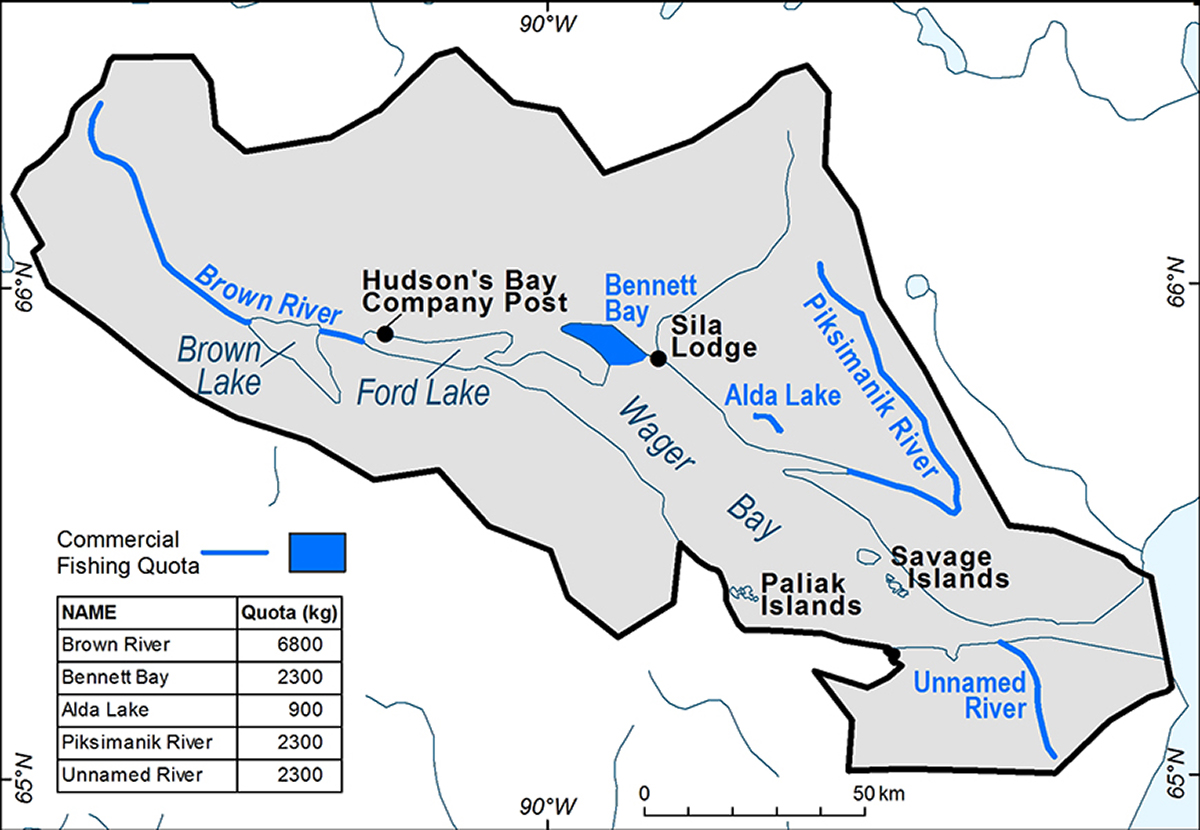
7.0 Summary of Strategic Environmental Assessment
Parks Canada is responsible for assessing and mitigating the impacts of management actions on ecosystems and on cultural resources. In accordance with The Cabinet Directive on the Environmental Assessment of Policy, Plan and Program Proposals (2010), a strategic environmental assessment (SEA) was conducted for the Ukkusiksalik National Park Management Plan. The purpose of SEA is to incorporate environmental considerations into the development of public policies, plans, and program proposals to support environmentally-sound decision making. The following is a summary of the environmental assessment.
The intent of the park management plan is to continue providing an enhanced level of protection to the exceptional ecological diversity and integrity of an area representative of the Central Tundra Natural Region and to sustain and give recognition to the history of human relationships with the landscape. Environmental and cultural components of note at the park include Wager Bay with its two polynyas that provide an important resource for a variety of marine wildlife and approximately 450 known cultural sites.
Implementation of the plan will result primarily in positive results. The understanding and management of natural and cultural resources will benefit from research and monitoring that is collaborative with local and regional partners and integrated with traditional knowledge. The ecological integrity monitoring program will also be further developed. Elements of the environment important to visitor experience will benefit from the development of interpretive products and visitation/wildlife viewing guidelines.
The development of appropriate facilities for protection, presentation, and promotion of the park will be managed and mitigated through the environmental impact assessment process under the Nunavut Planning and Project Assessment Act. Other strategies are proposed in the plan with positive impacts such as the increased research and monitoring of natural and cultural resources and enhancement of visitor experience through the development of interpretive products and visitation/wildlife viewing guidelines. Additionally, existing policies such as park zoning protect the majority of the park as zone I (special preservation), zone II (wilderness) and Areas of Special Importance to Inuit.
Public and Indigenous engagement was conducted on the plan. The Ukkusiksalik Park Management Committee, the Nunavut Wildlife Management Board, and Inuit from the park’s five adjacent communities were involved in the preparation of the management plan.
There are no important negative environmental effects anticipated from implementation of the Ukkusiksalik National Park Management Plan.
8.0 Acknowledgements
The preparation of this Management Plan involved many people. The input of this diverse group of individuals will result in a plan that will guide the management of the park for many years. The following individuals have made a special contribution and deserve mention:
Ukkusiksalik Park Planning Team
- Donna Parry, Nunavut Tourism
- Elizabeth Aglukka, Ukkusiksalik Park Management Committee
- John Tatty, Ukkusiksalik Park Management Committee
- Monty Yank, Park Manager, Parks Canada
Ukkusiksalik Park Management Committee
- Donat Milortok, Naujaat
- Elizabeth Aglukka, Naujaat
- Jackie Nakoolak, Chair, Coral Harbour
- Joan Scottie, Baker Lake
- John Tatty, Rankin Inlet
- Larry Tautu, Chesterfield Inlet
Naujaat Inuit Knowledge Working Group
- Elizabeth Kidlapik, Hunters and Trappers Organization
- Honore Aglukka, Elder
- Jimmy Immingark, Hunters and Trappers Organization
- Mary Tuktudjuk, Elder/Chair
- Solomon Malliki, Youth Representation
Related links
- Annual management plan implementation update 2021-2022
- Annual management plan implementation update 2019-2020
- Annual management plan implementation update 2018
- Management plan consultation report
- ᐅᒃᑯᓯᒃᓴᓕᒃ ᑲᓇᑕᒥ ᒥᕐᖑᐃᓯᕐᕕᒃ ᐊᐅᓚᑦᑎᓂᕐᒧᑦ ᐸᕐᓇᐅᑎ 2018-ᒥ
- ᐊᕌᒍᓕᒫᖅ ᐊᐅᓚᓯᓂᕐᒧᑦ ᐸᕐᓇᐅᑎᐅᑉ ᐊᑐᓕᕐᑎᑕᐅᓂᖓᑕ ᖃᓄᐃᓕᖓᓕᕐᓂᖓ 2021-2022
- ᐊᕌᒍᓕᒫᖅ ᐊᐅᓚᓯᓂᕐᒧᑦ ᐸᕐᓇᐅᑎᐅᑉ ᐊᑐᓕᕐᑎᑕᐅᓂᖓᑕ ᖃᓄᐃᓕᖓᓕᕐᓂᖓ 2019-2020
- ᐊᕌᒍᓕᒫᖅ ᐊᐅᓚᓯᓂᕐᒧᑦ ᐸᕐᓇᐅᑎᐅᑉ ᐊᑐᓕᕐᑎᑕᐅᓂᖓᑕ ᖃᓄᐃᓕᖓᓕᕐᓂᖓ 2018
- Date modified :